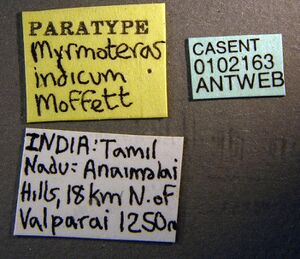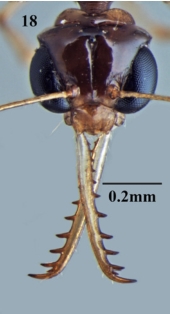Myrmoteras indicum
| Myrmoteras indicum | |
|---|---|

| |
| Scientific classification | |
| Kingdom: | Animalia |
| Phylum: | Arthropoda |
| Class: | Insecta |
| Order: | Hymenoptera |
| Family: | Formicidae |
| Subfamily: | Formicinae |
| Tribe: | Myrmoteratini |
| Genus: | Myrmoteras |
| Species: | M. indicum |
| Binomial name | |
| Myrmoteras indicum Moffett, 1985 | |
Occurring at higher elevations in Western Ghats and Nilgiris, India.
Photo Gallery
Identification
Moffett (1985) - The only species in the bakeri group from India. Workers can be distinguished from those of Myrmoteras bakeri by having a single apical denticle and relatively slender tibiae (TWI < 21); and from Myrmoteras diastematum by the lack of a wide sulcus between the clypeus and head capsule; and from both species by the reduced palpal segmentation (3,3 or 4,3).
All material ascribed to M. indicum is very similar to the type series in most respects. However, the series can be divided into two groups: palpal segmentation of 3,3 and lack preapical denticles, as in the type series, and females with 4,3 palpal segmentation, and at least one (sometimes two) preapical denticles. In addition, in several series the propodeum of the females is more or less conspicuously transversely rugose (with rugae extending obliquely over sides and posterior declivity smooth); in all other series the propodeum is smooth (with traces of rugae in some queens).
Further variation between series occurs across both groups: pilosity varying from sparse to dense (with more than 20 hairs breaking dorsal margin of trunk viewed); zero to one hair on or near each metathoracic tubercle, or more than that number; frontal area not demarcated to well developed; variation in width of the frontal furrow; presence or absence of feeble longitudinal rugae between antennal fossae; orbital grooves moderately developed to conspicuous. Randomly selected individuals measured from all series ranged in size from 0.88 to 1.09 mm (n = 24), and CI ranged from 92 to 103 in 14 selected individuals.
Bharti and Akbar (2014) - M. indicum belongs to subgenus Myagroteras and is characterized by the labrum having rounded anterior margin with pair of short conspicuous hairs instead of long trigger hairs (characteristic of subgenus Myrmoteras), strongly developed frontal sulcus and relatively longer mandibles (ML 1.20). M. indicum shares most affinities with Myrmoteras bakeri and Myrmoteras diastematum. M. indicum can be distinguished from M. bakeri by having a single apical denticles and relatively slender tibiae (TWI < 21) and from M. diastematum by the lack of wide sulcus between the clypeus and head capsule; and from both species by the reduced palpal segmentation.
Keys including this Species
Distribution
Collingwood et al. (2011) report males found in the United Arab Emirates as likely introduced with imported plant material and belonging to an Indian species, given as Myrmoteras cf. indica. As far as known this species does not occur outside its native range.
Distribution based on Regional Taxon Lists
Oriental Region: India (type locality).
Distribution based on AntMaps
Distribution based on AntWeb specimens
Check data from AntWeb
Countries Occupied
| Number of countries occupied by this species based on AntWiki Regional Taxon Lists. In general, fewer countries occupied indicates a narrower range, while more countries indicates a more widespread species. |

|
Estimated Abundance
| Relative abundance based on number of AntMaps records per species (this species within the purple bar). Fewer records (to the left) indicates a less abundant/encountered species while more records (to the right) indicates more abundant/encountered species. |

|
Biology
Moffett (1985) - All collections of this species were made at altitudes between 450 and 2,150 m, suggesting M. indicum is restricted to higher elevations. This choice of habitat and the consequent fragmentation of the species into numbers of relatively isolated populations could account for the minor character differences between localities. That the series consistently fall out into two groups on the basis of palpal segmentation and preapical denticle number is more difficult to explain and could be evidence for the existence of two sibling species. All the series are from a relatively small area of the Western Ghats and Nilgiris, and the two groups do not separate geographically in any obvious way.
A mating swarm of these ants was observed by Kalesh Sadasivan in Karala, India. The queens would locate themselves on exposed shrubs in open sun. Hundreds of males would flock to these queens, forming a mating frenzy! The mating swarm was on everything in the vicinity, on vegetation, on cameras and camera flashs, on the hands and clothes of the photographer. The entire mountain range, on its sun-exposed side and within 2 -3 meters of the ground, was full of males and females! While the actual number was difficult to estimate, it may have been in the millions. Based on an informal sampling of one square meter of vegetation, the male:female ratio was around 50-100:1 or so.
Castes
Worker
Images from AntWeb
   
| |
| Queen (alate/dealate). Specimen code casent0102163. Photographer April Nobile, uploaded by California Academy of Sciences. | Owned by MSNG, Genoa, Italy. |
Queen

| |
| . | |
Male
Images from AntWeb
   
| |
| Male (alate). Specimen code casent0102162. Photographer April Nobile, uploaded by California Academy of Sciences. | Owned by MSNG, Genoa, Italy. |
Nomenclature
The following information is derived from Barry Bolton's Online Catalogue of the Ants of the World.
- indicum. Myrmoteras (Myagroteras) indicum Moffett, 1985b: 37, figs. 4, 7-10, 27, 30 (w.q.m.) INDIA.
Unless otherwise noted the text for the remainder of this section is reported from the publication that includes the original description.
Description
Worker
Holotype (HW 1.03 mm) and four paratypes from the same locality: TL 5.3 to 5.9, HW 0.94 to 1.05, HL 1.00 to 1.12 (CI 92 to 95), ML 1.53 to 1.70 (MI 100 to 108), SL 1.18 to 1.31 (SI 124 to 127), EL 0.63 to 0.68, HFL 1.22 to 1.26 (TWI 16 to 17), WL 1.53 to 1.60 mm. Frontal sulcus conspicuous but narrow; orbital grooves moderately developed. Frontal area clearly defined. Palpal segmentation 3,3 (10 workers inspected). Mandibles with 11 to 13 teeth (usually 12) and without preapical denticles. Only one apical denticle, although this one is relatively large.
Pronotum low and evenly convex; propodeum evenly rounded, summit higher than mesothorax; metanotal groove not visible as a notch in profile. In several specimens the propodeum balloons out below the level of the spiracle (as occurs in males), but otherwise such individuals appear little different. The propodeum is more conventionally shaped in most paratypes and in all other material associated with this species. Node of petiole moderately thick; anterior face straight and vertical, posterior face less steep and curving gently into summit; summit rounded and moderately wide.
Head smooth, but some workers with traces of longitudinal rugae immediately above clypeus; pronotum smooth; mesonotum with feeble longitudinal rugae present laterally below a conspicuous ruga which extends forward from each metathoracic tubercle; mesonotum dorsally with finely transverse rugae showing traces of granulate sculpture; propodeum virtually smooth but with traces of transverse rugae dorsally in some; remainder smooth. Pilosity sparse, with less than 10 hairs breaking dorsal margin of trunk when viewed in profile. Hairs rising 0.08 to 0.10 mm on head, trunk and gaster; zero to one hair on or near each metathoracic tubercle and two to five on node of petiole. Reddish orange head, trunk, and gaster (the latter with a touch of brown), petiole and antennae orange yellow; legs and mandibles same but lighter.
Queen
Paratypes from the type series (two measured): TL 6.2, HW 1.11, HL 1.12 to 1.15 (CI 96 to 99), ML 1.66 to 1.68 (MI 144 to 150), SL 1.31 to 1.33 (SI 118 to 120), EL 0.69 to 0.70, HFL 1.40 to 1.41 (TWI 19), WL 1.62 to 1.64 mm. Trunk smooth except for usual transverse rugae on cervix and a row of very short, feeble transverse rugae along median line dorsad on propodeum, not extending onto sides laterally (although surface sometimes indistinctly rugose below level of spiracle on sides).
Male
Paratypes from the same locality as holotype (two measured): HW 0.75, HL 0.85 to 0.86 (CI 87), SL 1.20 to 1.21 (SI 160), EL 0.43, WL 1.40 to 1.44 mm. Frontal sulcus well defined, wide near median ocellus. Scapes long, more than 1.5 x HW. Palpal segmentation same as females. Head and trunk smooth outside of conspicuous irregular rugae on cervix and on propodeum (but smooth beneath propodeal spiracle on sternites, which bulge somewhat).
Type Material
Holotype. Worker deposited in Musee d'Histoire Naturelle Genève from India: Tamil Nadu: Anaimalai Hills, 18 km au nord de Valparai, 1,250 m, 18.XI.1972, #35 [tamisages en foret] (C. Besuchet and I. Lobl). Twenty-two workers, three alate queens, three dealate queens, and seven males, same locality and collection number as holotype (MHNG, Museum of Comparative Zoology, The Natural History Museum, Museo Civico di Storia Naturale, Genoa).
Etymology
Name in reference to the country of origin.
References
- Bharti, H., Akbar, S.A. 2014. Taxonomic studies on the genus Myrmoteras Forel (Hymenoptera: Formicidae), with description of two new species from India. J. Entomol. Res. Soc., 16, 71-80.
- Cantone S. 2017. Winged Ants, The Male, Dichotomous key to genera of winged male ants in the World, Behavioral ecology of mating flight (self-published).
- Collingwood, C.A., Agosti, D., Sharaf, M.R., van Harten, A. 2011. Order Hymenoptera, family Formicidae. Arthropod fauna of the UAE 4: 405-474.
- Moffett, M.W. 1985b. Revision of the genus Myrmoteras (Hymenoptera: Formicidae). Bulletin of the Museum of Comparative Zoology. 151:1-53. (page 37, figs. 4, 7-10, 27, 30 worker, queen, male described)
References based on Global Ant Biodiversity Informatics
- Dad J. M., S. A. Akbar, H. Bharti, and A. A. Wachkoo. 2019. Community structure and ant species diversity across select sites ofWestern Ghats, India. Acta Ecologica Sinica 39: 219–228.
- Moffett M.W. 1985. Revision of the genus Myrmoteras. Bulletin of the Museum of Comparative Zoology 151: 1-53.
- Rajan P. D., M. Zacharias, and T. M. Mustak Ali. 2006. Insecta: Hymenoptera: Formicidae. Fauna of Biligiri Rangaswamy Temple Wildlife Sanctuary (Karnataka). Conservation Area Series, Zool. Surv. India.i-iv,27: 153-188.





